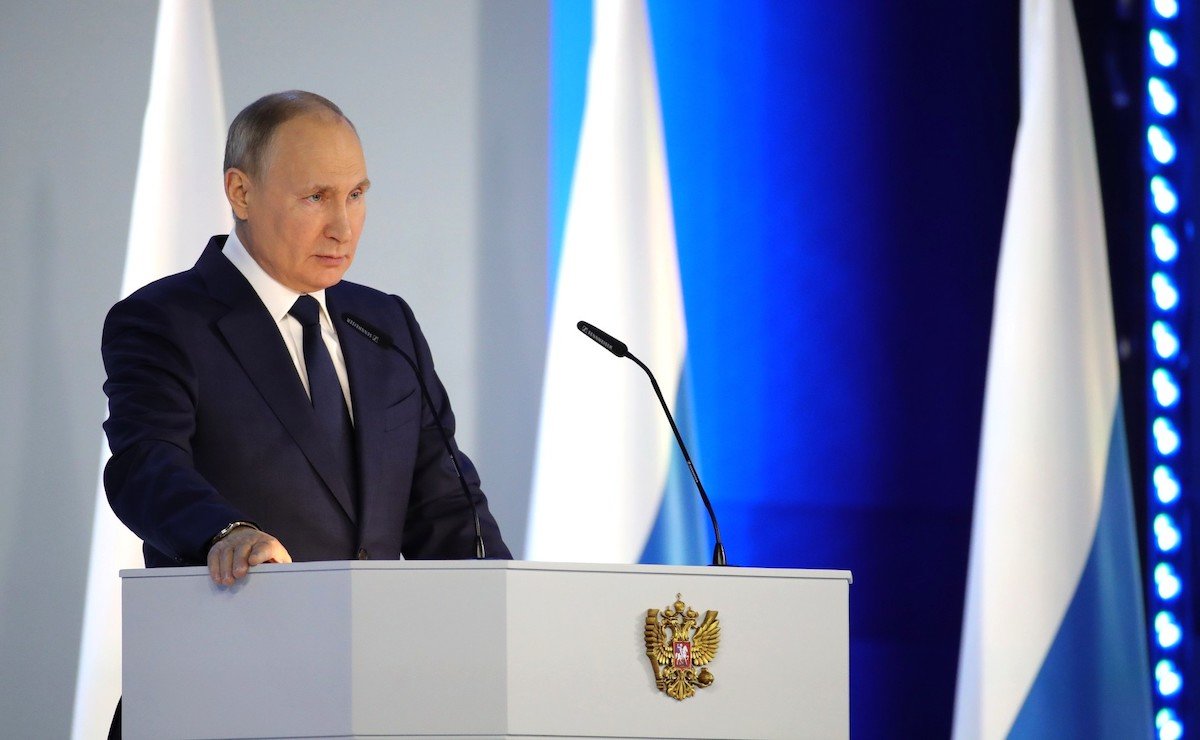Putin’s Partial Mobilization Order Foreshadows Drawn-Out War in Ukraine

Russian President Vladimir Putin delivers an address to Russia's Federal Assembly on April 21, 2021. Photo courtesy of the Russian Presidential Administration.
KYIV, Ukraine — Russia’s invasion of Ukraine did not go as planned. Rather than taking Kyiv in the full-scale war’s first 72 hours, as Moscow intended in February, Russian forces are now under pressure from separate Ukrainian counteroffensives in the south and east. Although about 80% of Russia’s ground forces remain committed to the “special military operation” in Ukraine, Russia has lost the battlefield initiative along the length of the 620-mile-long front line. Even so, Russian President Vladimir Putin is committed to continuing the war.
In a 20-minute morning address to his nation on Wednesday, Sept. 21, Putin announced the partial mobilization of reservists to raise 300,000 new troops for Russia’s failing war effort in Ukraine. In his remarks, Putin also accused NATO of “nuclear blackmail,” claiming the Western alliance had considered the use of nuclear weapons against Russia.
“If the territorial integrity of our country is threatened, we will certainly use all the means at our disposal to protect Russia and our people. It's not a bluff,” Putin said during Wednesday's address.
On Twitter Wednesday, independent Russian journalist Mikhail Fishman wrote, “Putin simply lost the war. He finally figured it out, but he can't deal with it because there's nothing he can imagine like victory. And to hide the failure, he will send new soldiers to their deaths. They will die so that he will avoid disgrace — for this reason alone.”
The partial-mobilization order, as Putin presented it, applies to Russian veterans with specialist skills, combat experience, or both. As part of its partial mobilization, Russia is also enacting what is basically a stop-loss program, which extends service contracts indefinitely.
Unconfirmed videos posted to social media throughout Wednesday purported to show a 35-kilometer-long (about 22 miles) traffic jam at the Russian border with Finland comprising Russian citizens looking to leave their country in the wake of Putin’s partial-mobilization order.
The invasion of Ukraine has taken a heavy toll on Russia’s military. According to Western estimates, roughly 75,000 Russian troops have been wounded or killed in combat — including many officers. Russia has also lost more than 5,000 pieces of equipment.
The effects of mobilization likely won’t be felt on the battlefield for months. Even then, the Russian military will be limited in the number of troops it can supply and control on the front lines in Ukraine. Officer losses are also hard to replace on short notice, underscoring the potential chain-of-command problems Russia’s military will face amid the influx of new troops. One line of thinking is that Russia's battlefield problems may already be insurmountable, and the additional troops will probably prolong the duration of hostilities rather than turn the war's tide in Moscow's favor.
“Even in a best-case scenario […] mobilization would take at least several months to a year to confer an operational benefit,” Dara Massicot, a senior policy researcher at the Rand Corp., wrote in an Aug. 15 piece for Foreign Affairs.
In a media interview, Russian Defense Minister Sergei Shoigu said that about 25 million Russians were eligible for mobilization. As of this article’s publication, it wasn’t immediately clear whether military-aged Russian men would be banned from leaving the country while mobilization is underway. Also, it remained unclear whether mobilized soldiers will be formed into stand-alone units or parceled out to fill manpower holes in front-line units already deployed to Ukraine.
Russian forces in Ukraine are constantly plagued by low morale, inadequate training, and the steady attrition of officers. Many experts agree that those qualitative problems will not be fixed by simply adding more soldiers on the front lines.
“Mobilization [and] stop-loss might help Moscow stem the deteriorating quantity of the force, but not the deteriorating quality of the force [and] its morale. Having used up its best equipment, officers, [and] personnel, I don't see how this can be recovered," Michael Kofman, director of the CNA Corp.’s Russia Center, tweeted on Wednesday.
Putin’s mobilization announcement came one day after Russian occupation authorities in southern and eastern Ukraine announced shotgun referendums, to be held from Friday to Tuesday, meant to decide whether those swaths of sovereign Ukrainian land will be annexed by Russia. The US and its allies condemned the move.
“We know that these referenda will be manipulated. We know that Russia will use these sham referenda as a basis to purportedly annex these territories either now or in the future,” US national security advisor Jake Sullivan told reporters in Washington on Tuesday.
According to the Institute for the Study of War, “Putin likely hopes to improve Russian force generation capabilities by calling on the Russian people to volunteer for a war to ‘defend’ newly claimed Russian territory.”
Ukraine’s recent successes have raised the possibility that Russia’s invasion campaign could be expelled from Ukraine altogether — including from territories in southeastern Ukraine that Russia invaded in 2014. Ukraine’s top defense officials have also openly raised the possibility of a Ukrainian operation to retake Crimea, a Ukrainian territory that Russia invaded and annexed in 2014.
If Moscow moves ahead with the annexation of Ukrainian territory after the upcoming referenda, it will assume a massive need for more manpower and materiel to hold and defend that land from Ukrainian attempts to get it back. That’s a tall order for Russia’s already depleted ground forces.
“There remains, in short, a mismatch between the Kremlin’s goals for Ukraine and the forces it has to deliver them,” Massicot wrote for Foreign Affairs.
According to the Institute for the Study of War, the annexation of Ukrainian territory will give Russian commanders more leeway to use undertrained conscripts on the front lines. Russian law requires that conscripted soldiers receive at least four months of training before deployments outside Russia’s borders. Russia currently conscripts about 130,000 soldiers, twice per year, the Institute for the Study of War reported.
For his part, Shoigu, the Russian defense minister, said regularly conscripted soldiers would not be sent to the “special military operation” war zone in Ukraine but would continue to serve on Russian soil.
Russian lawmakers are also looking to entice more foreigners into the ranks of Russia’s military. A new Russian law passed on Tuesday will grant Russian citizenship to any foreigner who serves as a contract soldier in Russia’s armed forces for one year — a reduction from the three years of military service previously required for citizenship.
Ukraine’s military now has a window of a few months to press ahead with the current counteroffensives and regain as much sovereign Ukrainian land as possible before the effects of mobilization begin to show within the Russian camp.
“These coming months remain an important window of opportunity for [Ukraine] to retake territory. Over the winter the contest will likely be one more defined by attrition and reconstitution. The extent to which mobilization can help [Russia] reconstitute is unclear," Kofman wrote Wednesday on Twitter.
Read Next: Ukrainian Fighter Jets Now Carry US Missiles — Here’s How To Write a Message on One

BRCC and Bad Moon Print Press team up for an exclusive, limited-edition T-shirt design!
BRCC partners with Team Room Design for an exclusive T-shirt release!
Thirty Seconds Out has partnered with BRCC for an exclusive shirt design invoking the God of Winter.
Lucas O'Hara of Grizzly Forge has teamed up with BRCC for a badass, exclusive Shirt Club T-shirt design featuring his most popular knife and tiomahawk.
Coffee or Die sits down with one of the graphic designers behind Black Rifle Coffee's signature look and vibe.
Biden will award the Medal of Honor to a Vietnam War Army helicopter pilot who risked his life to save a reconnaissance team from almost certain death.
Ever wonder how much Jack Mandaville would f*ck sh*t up if he went back in time? The American Revolution didn't even see him coming.
A nearly 200-year-old West Point time capsule that at first appeared to yield little more than dust contains hidden treasure, the US Military Academy said.












